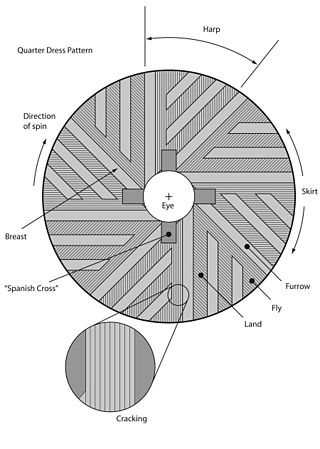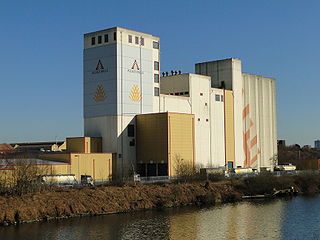This article relies largely or entirely on a single source .(September 2024) |
Kallo and the Goblins is a Greek fairy tale. Fani Papalouka, Nikolaos Politis, and Haris Sakellariou collected variants of the story. [1]
This article relies largely or entirely on a single source .(September 2024) |
Kallo and the Goblins is a Greek fairy tale. Fani Papalouka, Nikolaos Politis, and Haris Sakellariou collected variants of the story. [1]
A fat woman had an ugly older daughter, Marbo, and a beautiful younger daughter, Kallo. People admired Kallo and pitied Marbo; Marbo resented it and made Kallo do all the work. One day, the mother asked for one of them to go to the mill to grind flour; Marbo insisted on sending Kallo. Kallo got there, many people were grinding, and her grain was poured in just before the miller went to bed; she had to wait. At midnight, goblins came out and threatened to eat her. Kallo said they could not eat her in her old dress; she needed a new dress. When they stole a fine dress for her, she said she needed other things, a coat, an umbrella, a comb, face powder, and anything she could think of. Then dawn came, and the goblins had to leave. The miller ground her grain, and Kallo went back with what the goblins had given her and the flour.
Marbo envied her and wasted the flour. On New Year's Day, more was needed, and Marbo went for it. When the goblins came, they scratched her face, and she screamed for help; the miller saved her, but she gained nothing. Kallo used the goblins' face powder on her and healed her face.
The goblins of the title, the Kallikantzaros, live beneath the ground, trying to chop up the tree that holds up the earth. When it is nearly down, they know it is Christmas and come up to make mischief; they are driven back down at Epiphany, when the Greek Orthodox priests bless the waters. [1]

Millstones or mill stones are stones used in gristmills, used for triturating, crushing or, more specifically, grinding wheat or other grains. They are sometimes referred to as grindstones or grinding stones.

"The Reeve's Tale" is the third story told in Geoffrey Chaucer's The Canterbury Tales. The reeve, named Oswald in the text, is the manager of a large estate who reaped incredible profits for his master and himself. He is described in the Tales as skinny, bad-tempered, and old; his hair is closely cropped reflecting his social status as a serf. His sword is rusty while he rides a fine gray horse called Scot. The Reeve is a skilled carpenter, a profession mocked in the previous "Miller's Tale". Oswald responds with a tale that mocks the Miller's profession.

Watson's Mill is an historic flour and gristmill in Manotick, Ontario, Canada. It is the only working museum in the Ottawa area and one of the very few operating industrial grist mills in North America. Watson's Mill still sells stone-ground whole wheat flour which is made on site. The mill is also well known for its ghost Annabelle. The legend is that Ann Currier, wife of Joseph, haunts the mill, following her death in a tragic accident there in 1861. Watson's Mill is Manotick's most recognized landmark. Its image is used as a symbol for the village.

Diamonds and Toads or Toads and Diamonds is a French fairy tale by Charles Perrault, and titled by him "Les Fées" or "The Fairies". Andrew Lang included it in The Blue Fairy Book. It was illustrated by Laura Valentine in Aunt Louisa's nursery favourite.

The Three Heads in the Well is a fairy tale collected by Joseph Jacobs in English Fairy Tales.

"Allerleirauh" is a fairy tale recorded by the Brothers Grimm. Since the second edition published in 1819, it has been recorded as Tale no. 65. Andrew Lang included it in The Green Fairy Book.

Vasilisa the Beautiful or Vasilisa the Fair is a Russian fairy tale collected by Alexander Afanasyev in Narodnye russkie skazki.

"Katie Woodencloak" or "Kari Woodengown" is a Norwegian fairy tale collected by Peter Christen Asbjørnsen and Jørgen Moe in Norske Folkeeventyr. Andrew Lang included it in The Red Fairy Book.
Snow-White-Fire-Red (Bianca-comu-nivi-russa-comu-focu) is a Sicilian fairy tale collected by Giuseppe Pitre and translated by Thomas Frederick Crane in Italian Popular Tales.
The Two Caskets is a Scandinavian fairy tale included by Benjamin Thorpe in his Yule-Tide Stories: A Collection of Scandinavian and North German Popular Tales and Traditions. Andrew Lang included it in The Orange Fairy Book.

"Donkey Cabbages" is a German fairy tale collected by the Brothers Grimm, tale number 122. A man shoots birds in a forest and gains magical objects. By also ingesting the heart of one of the birds he shot, he acquires an inexhaustible source of wealth. Later on, his magical abilities and items are stolen by a trio of witches, but he regains everything thanks to a magical herb that causes one to transform into a donkey.
The Grateful Prince is an Estonian fairy tale. The tale is classified in the Aarne-Thompson-Uther Index as ATU 313, "The Magic Flight".
King Kojata or The Unlooked for Prince or Prince Unexpected is a Slavonic fairy tale, of Polish origin. Louis Léger remarked that its source was "one of the most important collections of Polish literature".
The Little Good Mouse is a French literary fairy tale written by Madame d'Aulnoy. Andrew Lang included it in The Red Fairy Book.

Finette Cendron is a French literary fairy tale written by Madame d'Aulnoy.
Babiole is a French literary fairy tale, written by Madame d'Aulnoy. In English publications, the name is sometimes translated as Babiola.

The Old Witch is an English fairy tale published by Joseph Jacobs in his 1894 book, More English Fairy Tales. It is also included within A Book of Witches by Ruth Manning-Sanders and A Book of British Fairy Tales by Alan Garner. Neil Watkins has researched the story of ‘The Old Witch’. In "The Watkins Book of English Folktales" PP.55-60 Watkins records that the story was told by a nine year old girl called Nora to Ellen Chase in Deptford in 1892. Ellen Chase gave her copy of the story to Mrs Gomme, who then sent it to Joseph Jacobs. Watkins notes that “It is at once clear that the Gomme/Jacobs text is a radical revision of the original, rather than a slight brushing-up for publication.” Chase’s original notes were published in FLS News as ‘The Witch and her Servant’ and is re-produced in Watkins pp.58-59.
Beauty and Pock Face is a Chinese fairy tale collected by Wolfram Eberhard in Chinese Fairy Tales and Folk Tales.

A gristmill grinds cereal grain into flour and middlings. The term can refer to either the grinding mechanism or the building that holds it. Grist is grain that has been separated from its chaff in preparation for grinding.
The Man and the Girl at the Underground Mansion is a Danish folktale collected by theologue Nikolaj Christensen in the 19th century, but published in the 20th century by Danish folklorist Laurits Bodker.